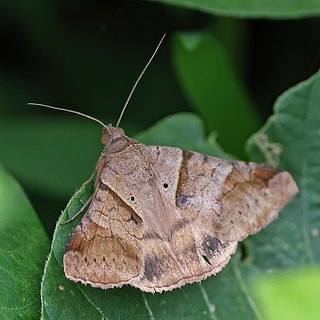
Mocis undata, the brown-striped semilooper, is a moth of the family Erebidae. The species was first described by Johan Christian Fabricius in 1775. It is found in the Afrotropical and Oriental regions, including India and Sri Lanka.

Erebus macrops, the common owl-moth, is a species of moth of the family Erebidae first described by Carl Linnaeus in 1768. It is found in the subtropical regions of Africa and Asia. The wingspan is about 12 cm, making it exceptionally large for an Erebidae species. The larvae feed on Acacia and Entada species.
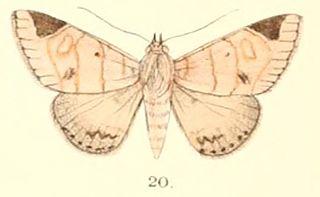
Dordura is a monotypic moth genus of the family Noctuidae erected by Frederic Moore in 1882. Its only species, Dordura aliena, was first described by Francis Walker in 1865. It is found in the Indian subregion, Sri Lanka, Myanmar, Thailand, Peninsular Malaysia, Sumatra, Borneo and New Guinea.
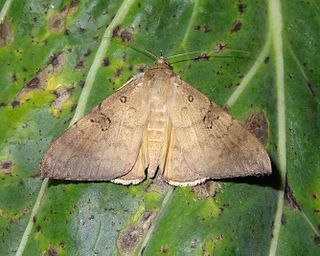
Oxyodes scrobiculata, the longan semi-looper or longan leaf-eating looper, is a moth of the family Erebidae. The common name "looper" is used despite looper moths generally being in the family Geometridae. The species was first described by Johan Christian Fabricius in 1775. It is found in the Indo-Australian tropics of India, Sri Lanka, Myanmar, China, Taiwan, east to Guam, Queensland, New Caledonia, Fiji, Samoa and Tonga.

Bastilla arctotaenia is a moth of the family Noctuidae. It is found from Japan, Korea and the Indo-Australian tropics throughout to India, Sri Lanka, Myanmar east to New Guinea and Queensland. It has also been recorded in Vanuatu and Fiji.
Ulotrichopus rama is a moth of the family Erebidae first described by Frederic Moore in 1885. It is found on Sumatra, Flores and Sri Lanka.
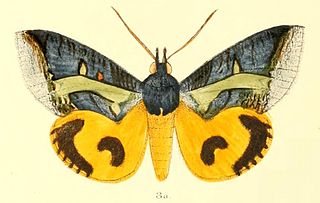
Eudocima homaena is a moth of the family Erebidae first described by Jacob Hübner in 1816. It is found in the Indian subregion, Sri Lanka, Myanmar, Taiwan, the Nicobars, Peninsular Malaysia, Borneo, the Philippines and on Christmas Island. It is a major pest on orange plants.

Berta chrysolineata is a species of moth of the family Geometridae described by Francis Walker in 1863. It is widespread from the Indo-Australian tropics of India, Sri Lanka to the Solomons.
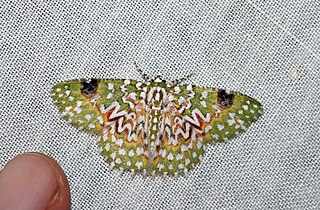
Eucyclodes gavissima, the Oriental orange banded green geometer moth, is a species of moth of the family Geometridae described by Francis Walker in 1861. It is found in the Indian subregion, Sri Lanka, Bhutan, western China, Taiwan, Vietnam, Sumatra and Borneo.

Sympis rufibasis is a moth of the family Noctuidae first described by Achille Guenée in 1852. It is found from the Indo-Australian tropics of India, Sri Lanka, Borneo east to New Guinea, the Solomons and Queensland.

Ischyja manlia is a species of moth of the family Noctuidae first described by Pieter Cramer in 1776. It is found in the Indian subregion, Sri Lanka, Myanmar, Thailand, China, Okinawa, Sundaland, Sulawesi, Korea, the southern Moluccas, Australia (Queensland) and Palau.

Blasticorhinus rivulosa is a moth of the family Noctuidae. It is found in Japan, Taiwan, India and Sri Lanka.
Asura rubricosa is a moth of the family Erebidae. It is found in India and Sri Lanka.
Asura floccosa is a moth of the family Erebidae. It is found in India and Sri Lanka.
Asura ila is a moth of the family Erebidae. It is found in India and Sri Lanka.
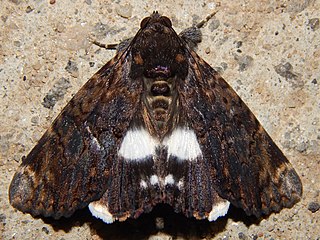
Nagia linteola is a species of moth in the family Erebidae first described by Achille Guenée in 1852. This species occurs in South Africa, the Democratic Republic of the Congo, Yemen, the Comoros, Mauritius, Madagascar, Indonesia (Borneo), India, Sri Lanka, Myanmar, Thailand and in Australia, where it has been recorded from Western Australia, the Northern Territory, Queensland and Victoria.
Asura ruptifascia is a moth of the family Erebidae. It is found in India and Sri Lanka.
Asura semifascia is a moth of the family Erebidae. It is found in Sri Lanka and Myanmar.
Asura solita is a moth of the family Erebidae. It is found in Sri Lanka.

Sphingomorpha chlorea, the sundowner moth, is a species of moth in the family Erebidae that is native to Africa and southern Asia. The species was first described by Pieter Cramer in 1777. It is a fruit-piercing moth and a notorious pest in orchards. The fruit is pierced while performing a vertical and rhythmic movement of the head.












